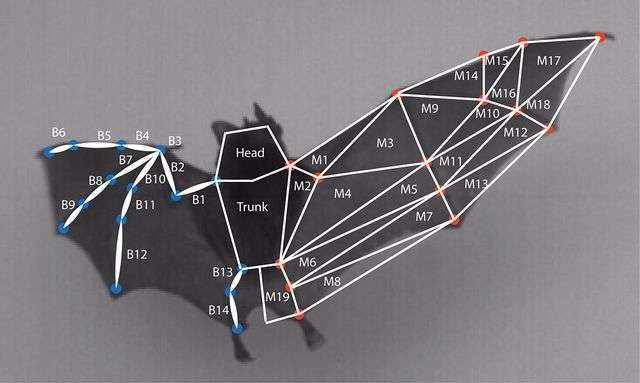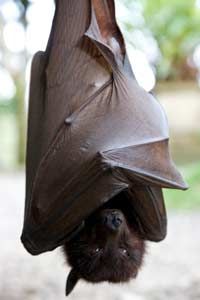
Bats fly head first, belly down, wings stretched out to the side, just as you might expect. So how do they land upside down, a position that requires the mid-air acrobatics of a circus flyer?
Before we get to that question, we first need to look at why bats would even want to land upside down to begin with? No other flying animal lands this way. Why not just land like birds do, with their feet firmly under their bodies?
Advertisement
The short answer is because bats wouldn't be strong enough to take off if they were upright. Their wings don't produce enough lift and their legs are too short to run along the ground to generate enough speed to get them into the air from a head-above-feet position. Instead they climb up high and literally fall into flying. By landing and roosting upside down, they're ready to take flight if something threatens their sleep.
So that's the "why." How do they get into this position when they aren't flying very fast and they can't hover upside down? It's all about inertia. Inertia involves Newton's first law of motion, which says a body at rest will stay at rest unless an outside force acts on it, and a body in motion will continue in a straight line unless acted upon by an outside force. Here's where inertia comes in. Inertia is proportional to a body's mass, which is the amount of matter that a body has. The more mass, the more inertia.

But how does this relate to bats? They don't have much mass — they're small. Well, here's the thing: bat wings have a lot of mass relative to their body size. Their wings have evolved to be made up of solid bones and muscles, so are heavier than the wings of most flying critters, which would suggest that it might be difficult to get off the ground —remember, they fall into flight. However, that same mass, when acted on by an outside force — such as a tiny little movement of the wings while in motion — will reorient the bat and get him or her upside down.
Researchers at the Brown University bat lab (or as it's officially known the Aeromechanics and Evolutionary Morphology Lab) recently studied bat landings using cameras to capture the movements of bats and discovered that as they got closer to the ceiling of their enclosure, they pulled one wing in closer to their bodies while still flapping the other wing at full extension. This allowed the bats to rotate to the right position to land feet first on the ceiling. (Think about a one-legged duck swimming in circles, or a rowboat paddling on just one side.)
If you haven't yet, watch the video above to understand more. But bats aren't the only animals that exhibit inertial reorientation, as the researchers call it.
"This kind of maneuvering is similar to the mechanism used by cats to reorient to land on their feet," says study author and principle investigator Sharon Swartz, "but is also used in many other animals. Geckos move their big tails in this way to stabilize themselves during climbing and righting; lemurs use this mechanism in their big jumps. We humans employ this sort of movement when gymnasts or springboard divers execute somersaults or twists, or when a figure skater changes the speed of a spin by changing the details of [the] position of arms or legs."
Advertisement

